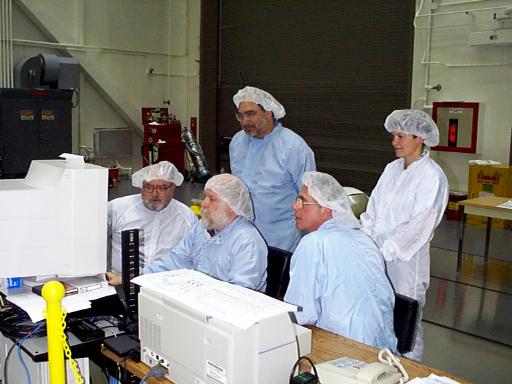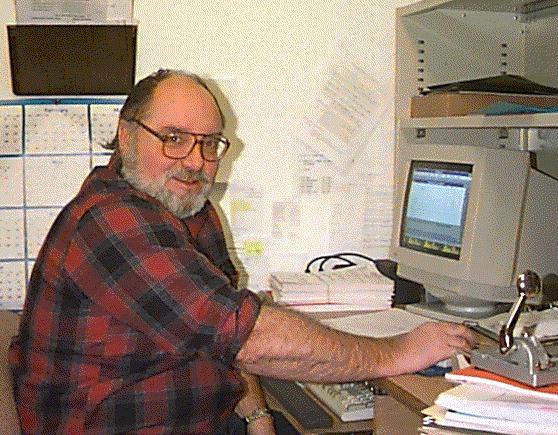Gerald K. Austin (1940–2023)
Our colleague and friend Jerry Austin passed away on December 3, 2023, after an illness of several years. Jerry was born in Detroit, Michigan, and, after graduating from Michigan State University, Jerry came to the Boston area to study mechanical engineering at MIT. In the mid-1960's, he joined the X-ray astronomy group led by Riccardo Giacconi at American Science and Engineering (AS&E). From our perspective he never left the field or our X-ray astronomy team for the remainder of his years.We fully recognize that this brief article cannot possibly capture the breadth and depth of Jerry's enormous contributions to the field of X-ray astronomy. His work with colleagues and friends was a major factor in the tremendous growth and success of the Smithsonian Astrophysical Observatory (SAO) and the Center for Astrophysics (CfA) over the past 50 years. He was ever-present and often the unofficial overseer of many incredibly challenging and ultimately successful projects. His unassuming title in later years of General Engineer hardly begins to describe everything that he did—applying the range of skills and expertise he brought to every project—continuing even after his retirement in 2019.
One of us (HT) had the great fortune of starting his professional career at AS&E in 1968 working on the first NASA satellite dedicated to X-ray astronomy, for which Jerry soon became the lead mechanical engineer. When that satellite launched in December 1970, it was renamed Uhuru—Swahili for freedom—since it was launched just off the coast of Kenya on the 10th anniversary of Kenyan independence. Uhuru performed well beyond expectations, providing the first solid evidence for the existence of black holes, explaining how the bright X-ray sources in our Galaxy are powered, and discovering sources associated with “active galaxies” and clusters of galaxies. Simply stated, Jerry was integral to making those discoveries possible.
Soon afterwards, while still at AS&E, Jerry—along with Bruce Dias, Dave Boyd, Dick Goddard, Ed McLaughlin, Phil McKinnon, and Adrian Roy, among others—was instrumental in building the first X-ray mission with a true telescope: the HEAO-B, renamed the Einstein Telescope after launch in 1978. Following the integration of that payload, Jerry and the above-named engineers moved to SAO, joining the High Energy Astrophysics Division in 1977 to work more closely with Riccardo and the X-ray group there. Using the imaging power of the telescope and its cameras, the Einstein team demonstrated that essentially all classes of astronomical objects, ranging from nearby stars to distant quasars, radiate X-ray emission and constitute an essential channel for investigating and understanding how our universe works. It is fair to say that Jerry and his engineering colleagues were in the midst of every aspect of designing, building, and testing the Einstein science payload. No doubt, he knew more about that mission than anyone else. If, by chance, there was something he did not know, he knew where to get the information.
Following his work on the Einstein project, Jerry became heavily involved in the laboratory development of higher-performance, high resolution microchannel plate (MCP) X-ray imagers. He played a central role in demonstrating the capabilities of larger-format MCP detectors with higher quantum efficiency. These advancements during the 1980's were applied to the High Resolution Imager provided by SAO (through NASA) to the German-led ROSAT mission launched in 1990 (see more below).
Jerry's formal training was in mechanical engineering, but he was conversant in all engineering disciplines—mechanical, thermal, structural, electrical—required to bring complex projects together. He understood much of the physics of the detectors and their read-outs and easily and regularly interacted with the scientists.
Jerry's crowning achievement within X-ray astronomy was his leadership and management for designing, building, calibrating, and integrating the High Resolution Camera (HRC) for the mission that would be named Chandra after its launch in July 1999. SAO's Steve Murray was the Principal Investigator (PI) for that instrument. Steve and Jerry worked incredibly closely on the HRC, starting from the technology phase in the 1980's and continuing for many years after the launch. After Steve's untimely passing in 2015, one of us (RK) assumed the role of HRC PI.
The HRC was designed and built at SAO in Cambridge, Massachusetts, during the first half of the 1990's. For reasons that we can truly no longer recall, Jerry was formally the Quality Control engineer on the HRC instrument team. To no one's surprise but to everyone's delight, Jerry was effectively the lead Systems Engineer and led the technical development of the flight hardware and its integration into the spacecraft. He was involved in every step of the design and the flight build. In particular, he personally performed the assembly of the flight MCP stack into the camera housing along with Steve Murray and SAO scientist Jon Chappell in the HRC clean room. He wore the clean room bunny suit quite well! The assembled flight model (FM) HRC was inserted into the X-ray vacuum pipe at SAO for testing and calibration, with Jerry overseeing this laboratory evaluation to ensure that all performance requirements were met.
The FM was then transported to the X-Ray Calibration Facility (XRCF) at Marshall Space Flight Center (MSFC) in 1997 to perform a much more extensive calibration than could be done in the SAO lab. Tests at the XRCF verified the combined imaging performance of the High-Resolution Mirror Assembly (HRMA) with the HRC, as well as with the other Chandra science instruments. Jerry oversaw the safe transfer of the HRC to MSFC and its installation into the vacuum pipe at the XRCF. With the science team, he developed and tested all of the procedures for operation during the extensive ground calibration. The HRC was then transferred to Ball Aerospace in Boulder, Colorado, for integration onto Chandra's Science Instrument Module (SIM)—the translation stage used to select the appropriate science instrument and to adjust the focus for a Chandra observation. Once mounted on the SIM, the HRC underwent several weeks of thermal/vacuum testing, with Jerry again supervising the testing, developing the procedures, confirming the performance, and ensuring the health and safety of the instrument.

Jerry Austin (seated left) and Steve Murray (standing left) with members of the testing team during thermal/vacuum testing at TRW in 1998.
The HRC on the SIM was next transported to the TRW facility in Redondo Beach, California, in 1998 for integration onto the spacecraft. The integrated Chandra payload then underwent months of thermal, environmental, and electrical testing, with the HRC again under Jerry's calm supervision. Once testing was complete, the observatory was shipped to Kennedy Space Center for installation in the Shuttle Columbia. Jerry and Steve were part of a small team who had the opportunity to board Columbia once Chandra was installed to manually release a valve before launch. Chandra launched on July 23, 1999, with Jerry at KSC to witness the milestone.
After launch, Jerry quickly returned to the Chandra Operations Control Center (OCC) in Cambridge and was a central participant in the orbital activation of the HRC. He continued to play a key role monitoring the long-term health and safety of the flight instrument and approving adjustments deemed necessary. Sadly, his own health began to deteriorate several years ago, and a younger generation of scientists and engineers came on-board to continue operating the HRC. Yet even though he was retired, when unexpected power supply issues intermittently impaired and then halted operation of the HRC in mid-2022, Jerry continued to consult with the team. Eventually, the HRC team understood the problem and developed workarounds, enabling the resumption of high quality operations in April 2023—which are continuing as of July 2024.
Jerry handled the stress of playing such an important role on the HRC for nearly 3 decades with seeming ease. He always had an air of calm confidence even when things were chaotic. His approach was actually fairly simple: apply “Best Engineering Practices” in all cases and it would be hard to go wrong. He was ALWAYS prepared, no detail was too big or too small for him, and everyone trusted his judgment. Jerry was one of the few people that the HRC PI, Steve Murray, (and the three of us) would listen to without question! When Jerry said things should be done a certain way, that's how they got done.
For those interested in further details, there is a wonderful 1998 oral history involving Jerry Austin and Steve Murray covering their work on Uhuru, Einstein, ROSAT, and Chandra. The transcript can be found at:
https://www.aip.org/history-programs/niels-bohr-library/oral-histories/28614
In addition to technical and leadership roles for the X-ray projects described above, Jerry also took on a range of management and engineering roles for many CfA programs, first from within the High Energy Astrophysics Division and then after joining the Central Engineering Department in 2003. As already noted, he was lead engineer for the SAO development of the High Resolution Imager (based on the Einstein HRI) for the German-UK-US ROSAT mission launched in 1990. ROSAT carried out what was then the most-sensitive X-ray mapping of the entire sky in the 1990's. Jerry also applied his vast talents and unlimited energy to contribute substantially to the following instruments or missions: Skylab Apollo Telescope Mount S-054 X-ray telescope, Solar-B/Hinode X-Ray Telescope, Interface Region Imaging Spectrograph (IRIS), Stardust, Solar Dynamics Observatory Atmospheric Imaging Assembly, BepiColombo Strofio, and Parker Solar Probe Solar Wind Alphas and Protons (SWEAP) Investigation.
Within Central Engineering, Jerry wore many hats at various times, including Manager of Product Assurance, overseer for the transfer of critical documents from one storage facility to another, and a lead participant in the construction of the CfA's new engineering and instrumentation facility, starting from specification and design stages through contractor selection and on to oversight of the actual build. Jerry also served as acting Manager of Central Engineering when needed.
Jerry's diverse engineering background, vast problem-solving experience (which prevented several serious situations from occurring in major programs), tenacity, willingness to serve as a mentor for those at earlier career stages, penchant to volunteer for whatever organizational needs arose, extensive involvement with NASA (for which he received a number of awards), and overall role in blazing new trails in astronomy combine to illustrate the tremendous loss felt by so many of us. His experience at SAO was so varied and extensive that it would be impossible for even a team of people to fully appreciate, let alone replace. This loss speaks to how high he set the bar.
Gerald Austin was a great engineer and a tremendous colleague, and he had an unforgettable influence on everyone who had the pleasure of working with him. He played an absolutely critical role in the development of X-ray astrophysics in the United States for more than 50 years, with contributions to many important missions—some still operating today. Many of the scientists in our community probably never met Jerry, but a large fraction have benefitted from his work. His role in the development of X-ray astronomy over five decades cannot be understated. Jerry's work has had a profound impact on multiple generations of scientists and engineers who will carry his legacy onward for decades into the future.
Prepared by Harvey Tananbaum, Ralph Kraft, and Melinda Dillon

